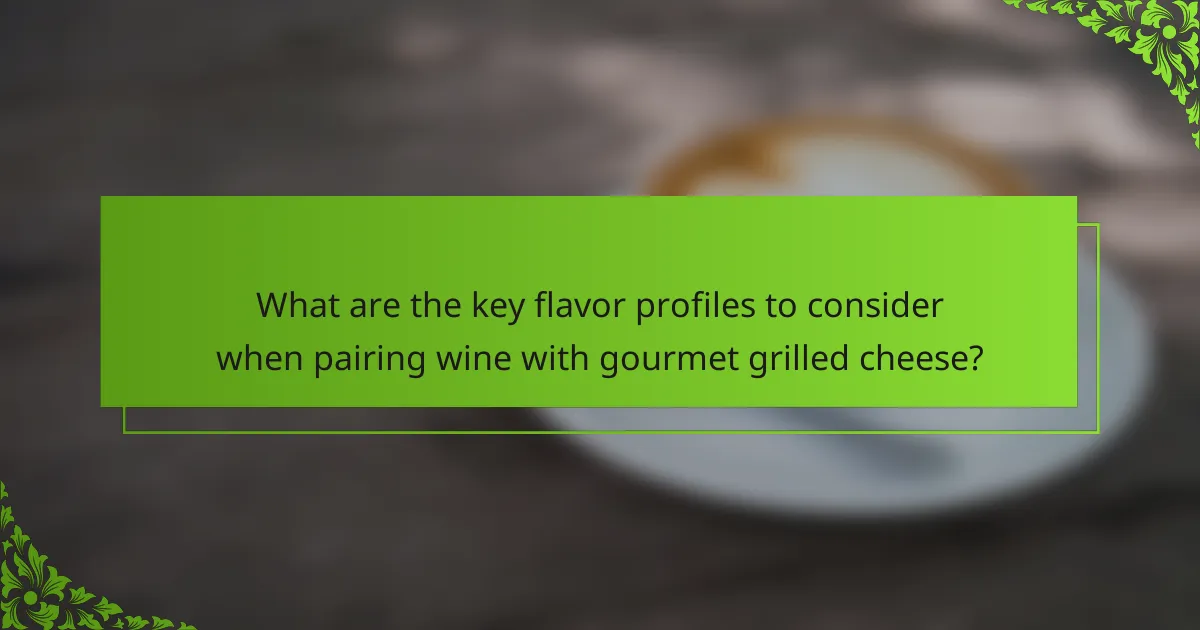Pairing wine with gourmet grilled cheese significantly enhances the dining experience by complementing the flavors of the cheese and bread. Key flavor profiles such as richness, acidity, and saltiness are essential in creating harmonious pairings. White wines like Chardonnay work well with creamy cheeses, while red wines such as Pinot Noir enhance sharper flavors. Specific serving suggestions include a crisp Sauvignon Blanc with goat cheese, a rich Chardonnay with Gruyère and caramelized onion, and a bold Cabernet Sauvignon with blue cheese. Understanding these combinations can elevate both the enjoyment of the wine and the grilled cheese dish.

What is the significance of pairing wine with gourmet grilled cheese?
Pairing wine with gourmet grilled cheese enhances the overall dining experience. The right wine complements the flavors of the cheese and bread. For instance, a rich Chardonnay can balance creamy cheeses, while a robust red can enhance sharp flavors. This pairing creates a harmonious flavor profile. Studies show that food and wine combinations can elevate taste perceptions. Proper pairings can also improve the enjoyment of both the wine and the dish. Thus, the significance lies in the enhancement of flavors and overall satisfaction.
How does the flavor profile of grilled cheese influence wine selection?
The flavor profile of grilled cheese significantly influences wine selection. Grilled cheese typically features rich, buttery, and savory flavors. These characteristics often pair well with wines that have balanced acidity and fruitiness. For example, a Chardonnay can complement the creaminess of the cheese. Its acidity cuts through the richness, enhancing the overall experience. Additionally, a light-bodied red like Pinot Noir can also work well. The wine’s fruit notes harmonize with the savory elements of the dish. Therefore, selecting a wine that matches the grilled cheese’s flavor profile maximizes the tasting experience.
What are the primary ingredients in gourmet grilled cheese that affect flavor?
The primary ingredients in gourmet grilled cheese that affect flavor are high-quality cheeses, artisanal bread, and flavorful spreads. High-quality cheeses like aged cheddar or Gruyère provide rich, complex flavors. Artisanal bread, such as sourdough or ciabatta, contributes texture and enhances taste. Flavorful spreads, including pesto or garlic butter, add depth and uniqueness to the sandwich. Each ingredient plays a crucial role in creating a memorable flavor experience.
How do different cheeses impact the choice of wine?
Different cheeses influence wine selection based on their flavor profiles and textures. Soft cheeses like Brie pair well with light-bodied wines such as Chardonnay. Hard cheeses, such as aged Gouda, complement full-bodied reds like Cabernet Sauvignon. Blue cheeses often match with sweet wines like Port, balancing the strong flavors. The saltiness of cheese can enhance the perception of acidity in wine. Creamy cheeses can soften tannins in red wines, creating a smoother experience. Each cheese type has unique attributes that guide optimal wine pairings. Understanding these relationships can elevate the overall tasting experience.
What are the best wine varietals for pairing with gourmet grilled cheese?
Chardonnay and Sauvignon Blanc are the best wine varietals for pairing with gourmet grilled cheese. Chardonnay complements creamy cheeses due to its buttery texture and acidity. It enhances flavors without overpowering them. Sauvignon Blanc offers a crisp acidity that balances rich, gooey cheeses. Its herbal notes can also match well with additional ingredients like herbs or vegetables. Pinot Noir is another excellent choice, especially with grilled cheese containing earthy ingredients. It has soft tannins that won’t clash with the cheese. These varietals are widely recognized for their compatibility with various gourmet grilled cheese combinations.
Which white wines complement the richness of grilled cheese?
Chardonnay and Sauvignon Blanc are white wines that complement the richness of grilled cheese. Chardonnay’s buttery notes enhance the creamy texture of melted cheese. Sauvignon Blanc offers acidity that cuts through the richness, balancing flavors effectively. Both varietals provide a refreshing contrast to the savory elements of grilled cheese. Studies show that the right wine pairing can elevate the dining experience. For instance, a 2017 study by the Wine Institute highlights how acidity and body in wine interact with food.
What red wines work well with various grilled cheese types?
Pinot Noir pairs well with most grilled cheese types. Its light body and acidity complement rich cheeses. For a classic cheddar grilled cheese, a medium-bodied Merlot enhances flavor. A Cabernet Sauvignon works well with aged Gruyère, offering boldness to match the cheese’s nuttiness. Zinfandel complements pepper jack grilled cheese due to its fruitiness and spice. Syrah pairs nicely with blue cheese grilled cheese, balancing the strong flavors. Each wine choice enhances the grilled cheese experience by matching flavor profiles.
How can the acidity and sweetness of wine enhance the grilled cheese experience?
The acidity and sweetness of wine can enhance the grilled cheese experience by balancing flavors. Acidity cuts through the richness of melted cheese. This creates a refreshing contrast that elevates the dish. Sweetness complements the savory notes of grilled cheese. It adds a layer of complexity to the overall taste. For instance, a Sauvignon Blanc offers high acidity, enhancing the cheese’s creaminess. A sweet Riesling can provide a delightful counterpoint to salty cheeses. These interactions create a harmonious pairing that enhances enjoyment.
What role does acidity play in food and wine pairing?
Acidity plays a crucial role in food and wine pairing. It enhances flavors and balances richness in dishes. High-acid wines, such as Sauvignon Blanc, complement fatty foods like grilled cheese. The acidity cuts through the creaminess, creating a harmonious experience. Additionally, acidity can refresh the palate, making each bite enjoyable. Research by the Wine Institute shows that wines with higher acidity are often more versatile in pairings. This is because they can enhance the overall taste of both the food and the wine.
How does sweetness in wine balance savory flavors in grilled cheese?
Sweetness in wine balances savory flavors in grilled cheese by creating a contrast that enhances the overall taste experience. The sweetness counteracts the richness and saltiness of the cheese. This interplay allows each flavor to stand out while harmonizing the palate. For example, a sweet Riesling can complement sharp cheddar, softening its intensity. Research shows that sweetness can elevate savory dishes by providing a refreshing counterpoint. This balance is essential in wine and food pairings, as it leads to a more enjoyable meal.

What are the key flavor profiles to consider when pairing wine with gourmet grilled cheese?
The key flavor profiles to consider when pairing wine with gourmet grilled cheese include richness, acidity, and saltiness. Richness comes from the cheese, which can be creamy or sharp. A wine with good acidity balances the richness of the cheese. Saltiness in the grilled cheese enhances the overall flavor experience. White wines like Chardonnay complement creamy cheeses well. Red wines such as Pinot Noir can pair nicely with sharper cheeses. Sweet wines can also work, especially with added ingredients like caramelized onions. These combinations create a harmonious tasting experience.
How do different cheese flavors interact with wine profiles?
Different cheese flavors interact with wine profiles through complementary and contrasting taste elements. For example, creamy cheeses like Brie pair well with fruity white wines. The wine’s acidity cuts through the richness of the cheese. Sharp cheeses, such as aged cheddar, harmonize with bold red wines. The tannins in red wines balance the cheese’s intense flavors. Blue cheeses have a pungent taste that matches well with sweet wines, like Port. The sweetness of the wine softens the cheese’s strong profile. Fresh cheeses, such as mozzarella, are best with light, crisp wines. Their mild flavor allows the wine’s characteristics to shine. Overall, successful pairings enhance both the cheese and wine experience.
What are the flavor notes of popular cheeses used in gourmet grilled cheese?
Popular cheeses used in gourmet grilled cheese include cheddar, gouda, fontina, and brie. Cheddar offers a sharp and tangy flavor profile. Gouda is known for its creamy, nutty, and slightly sweet notes. Fontina provides a rich, buttery flavor with earthy undertones. Brie has a soft texture and a mild, creamy taste with hints of mushrooms. These flavor notes enhance the overall experience of gourmet grilled cheese sandwiches.
How can wine enhance or contrast these cheese flavors?
Wine can enhance or contrast cheese flavors by complementing or balancing their taste profiles. For example, a rich, creamy cheese pairs well with a crisp, acidic white wine. This combination can cut through the cheese’s richness, enhancing the overall flavor experience. Conversely, a bold red wine can contrast with a mild cheese, bringing out subtle flavors that may otherwise go unnoticed. The tannins in red wine can also soften the texture of certain cheeses. Studies show that specific wine and cheese pairings can elevate the sensory experience, leading to a more enjoyable tasting.
What are some common mistakes to avoid when pairing wine with grilled cheese?
One common mistake when pairing wine with grilled cheese is selecting overly tannic wines. Tannins can clash with the creamy texture of cheese, resulting in an unpleasant taste. Another mistake is ignoring the cheese type. Different cheeses require different wine pairings to enhance flavors. Pairing a strong cheese with a delicate wine can overpower the wine’s nuances. Additionally, serving wine at the wrong temperature is a frequent error. White wines should be chilled, while reds are best served slightly below room temperature. Failing to consider the bread type is also crucial. The bread’s flavor and texture can impact the overall pairing experience. Lastly, not experimenting with pairings limits enjoyment. Trying various combinations can lead to delightful discoveries.
How can mismatched flavors detract from the dining experience?
Mismatched flavors can significantly detract from the dining experience. When flavors do not complement each other, they can create an unpleasant taste sensation. This can lead to a confusing palate, where no single flavor stands out. For example, a sweet wine paired with a savory grilled cheese may clash, overpowering the dish. Research indicates that flavor pairing enhances enjoyment; mismatched combinations can lead to dissatisfaction. A study published in the journal “Food Quality and Preference” found that harmonious flavors improve overall meal satisfaction. Therefore, careful consideration of flavor compatibility is essential for an enjoyable dining experience.
What are the consequences of overlooking wine temperature in pairings?
Overlooking wine temperature in pairings can significantly alter the tasting experience. Incorrect temperature can mask the wine’s aromas and flavors. For example, red wines served too cold may taste flat and lack complexity. Conversely, white wines served too warm can become overly sweet and lose their refreshing qualities. This misalignment can lead to an unbalanced pairing with food, diminishing the overall enjoyment. Studies show that optimal serving temperatures enhance the perception of a wine’s characteristics. Therefore, serving wine at the correct temperature is essential for a harmonious pairing with gourmet grilled cheese.

What are some serving suggestions for wine and gourmet grilled cheese pairings?
Serve a crisp Sauvignon Blanc with a goat cheese grilled cheese. This pairing enhances the tangy flavor of the cheese. A rich Chardonnay complements a Gruyère and caramelized onion sandwich. The wine’s buttery notes match the sandwich’s creaminess. Pair a light Pinot Noir with a mushroom and Swiss grilled cheese. The wine’s earthiness balances the umami flavors. For a spicy pepper jack grilled cheese, serve a fruity Riesling. The sweetness of the wine offsets the spice. Consider a bold Cabernet Sauvignon with a blue cheese grilled cheese. The wine’s tannins cut through the richness of the cheese.
How should wine be served to complement gourmet grilled cheese?
Wine should be served at a slightly chilled temperature to complement gourmet grilled cheese. Ideal serving temperature ranges from 50°F to 60°F for white wines and 60°F to 65°F for reds. This temperature enhances the wine’s flavor profile without overpowering the dish.
Pairing wines like Chardonnay or Sauvignon Blanc with creamy cheeses works well. For sharper cheeses, a light-bodied red like Pinot Noir can be effective.
Serving in appropriate glassware also enhances the experience. Use white wine glasses for whites and red wine glasses for reds. This allows for better aeration and aroma capture.
Additionally, consider decanting red wines to improve their flavor before serving. This practice allows the wine to breathe, enhancing its complexity.
What is the ideal serving temperature for different wine types?
The ideal serving temperature for different wine types varies significantly. Generally, white wines are best served chilled at 45-55°F (7-13°C). Red wines should be served at a slightly warmer temperature of 55-65°F (13-18°C). Sparkling wines are ideally served at 40-50°F (4-10°C) for optimal refreshment. Rosé wines are best at 50-60°F (10-15°C). These temperature ranges enhance the flavors and aromas of each wine type. Serving wines at their ideal temperatures can improve the overall tasting experience.
What glassware enhances the wine experience with grilled cheese?
A white wine glass enhances the wine experience with grilled cheese. This type of glass is designed to showcase the aromas and flavors of white wines. The bowl shape allows for better aeration. The narrow opening concentrates the aromas. For grilled cheese, a glass that highlights acidity and fruitiness is ideal. Chardonnay or Sauvignon Blanc pairs well with the dish. Using a white wine glass elevates the overall tasting experience.
What are some creative ways to present wine and gourmet grilled cheese together?
Serve wine in small carafes alongside gourmet grilled cheese for an elegant touch. Pair each cheese variant with a specific wine to enhance flavors. Use wooden boards to display grilled cheese slices, creating a rustic aesthetic. Include small tasting cups for wine, allowing guests to sample different pairings. Arrange garnishes like fresh herbs or fruits next to the cheese for added color. Present a wine and cheese flight, showcasing various combinations on a single platter. Utilize decorative napkins or themed plates to elevate the presentation. Engage guests by providing pairing cards that describe the flavor profiles of each combination.
How can pairing boards enhance the dining experience?
Pairing boards enhance the dining experience by offering a curated selection of complementary flavors. They allow diners to explore various taste combinations in one meal. This approach encourages social interaction as guests share and discuss their preferences. Pairing boards also visually appeal, creating an inviting presentation. Research shows that visual aesthetics can increase enjoyment and satisfaction during meals. Additionally, they provide a structured way to enjoy different wines and gourmet grilled cheese varieties. This structure helps guests appreciate the nuances of each pairing. Overall, pairing boards elevate both the flavor experience and the social aspects of dining.
What are some themed pairing ideas for events or gatherings?
Themed pairing ideas for events or gatherings include wine and gourmet grilled cheese. This combination enhances flavor profiles and creates a unique culinary experience. For instance, pairing a bold Cabernet Sauvignon with a sharp cheddar grilled cheese complements the richness of both. A light Sauvignon Blanc works well with a creamy Brie sandwich, balancing the flavors. Additionally, a fruity Pinot Noir pairs nicely with a smoked Gouda grilled cheese, enhancing the smokiness. These pairings can elevate events by offering guests a memorable tasting experience.
What are some practical tips for successful wine and gourmet grilled cheese pairings?
Select a wine that complements the cheese. For example, pair a rich, creamy cheese with a full-bodied white wine. Consider acidity levels in both the wine and the grilled cheese. High acidity wines cut through the richness of the cheese. Match the intensity of the wine with the flavor of the grilled cheese. A bold cheese requires a robust wine. Experiment with contrasting flavors, such as sharp cheddar with a fruity red. Serve the wine slightly chilled for whites and at room temperature for reds. Finally, consider the bread type, as it can influence the overall pairing experience.
The main entity of the article is the pairing of wine with gourmet grilled cheese. The article explores the significance of this pairing, highlighting how the right wine enhances flavors and elevates the dining experience. It discusses the influence of grilled cheese flavor profiles on wine selection, the impact of different cheeses on wine choices, and the best varietals for pairing, including Chardonnay, Sauvignon Blanc, and Pinot Noir. Additionally, it provides practical tips for successful pairings, serving suggestions, and common mistakes to avoid, ensuring a comprehensive understanding of how to achieve optimal wine and gourmet grilled cheese combinations.